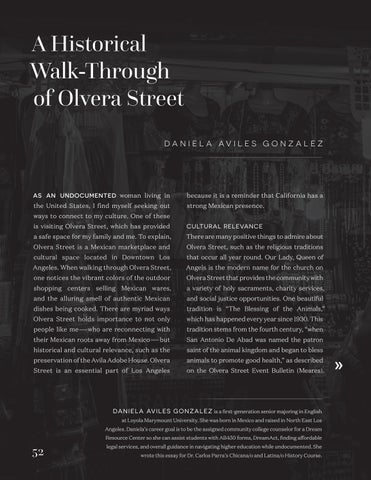A Historical Walk-Through of Olvera Street DA N I E L A AV I L E S G O N Z A L E Z
AS AN UNDOCUMENTED woman living in
because it is a reminder that California has a
the United States, I find myself seeking out
strong Mexican presence.
ways to connect to my culture. One of these is visiting Olvera Street, which has provided
CULTURAL RELEVANCE
a safe space for my family and me. To explain,
There are many positive things to admire about
Olvera Street is a Mexican marketplace and
Olvera Street, such as the religious traditions
cultural space located in Downtown Los
that occur all year round. Our Lady, Queen of
Angeles. When walking through Olvera Street,
Angels is the modern name for the church on
one notices the vibrant colors of the outdoor
Olvera Street that provides the community with
shopping centers selling Mexican wares,
a variety of holy sacraments, charity services,
and the alluring smell of authentic Mexican
and social justice opportunities. One beautiful
dishes being cooked. There are myriad ways
tradition is “The Blessing of the Animals,”
Olvera Street holds importance to not only
which has happened every year since 1930. This
people like me—who are reconnecting with
tradition stems from the fourth century, “when
their Mexican roots away from Mexico—but
San Antonio De Abad was named the patron
historical and cultural relevance, such as the
saint of the animal kingdom and began to bless
preservation of the Avila Adobe House. Olvera
animals to promote good health,” as described
Street is an essential part of Los Angeles
on the Olvera Street Event Bulletin (Meares).
DA N I E L A AV I L E S G O N Z A L E Z is a first-generation senior majoring in English at Loyola Marymount University. She was born in Mexico and raised in North East Los Angeles. Daniela’s career goal is to be the assigned community college counselor for a Dream Resource Center so she can assist students with AB450 forms, DreamAct, finding affordable
52
legal services, and overall guidance in navigating higher education while undocumented. She wrote this essay for Dr. Carlos Parra’s Chicana/o and Latina/o History Course.
»











